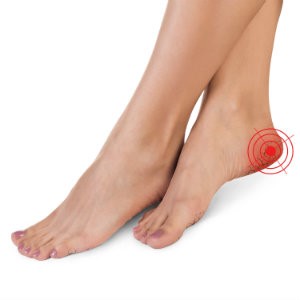By: Dr. Alyssa Musgrove
Have you ever experienced excruciating pain in the bottom of the foot or heel? Does your first step out of bed in the morning feel like you stepped on a knife? Sharp pain in the heel or stabbing pain in the bottom of the foot can be debilitating. Plantar fasciitis (fashee-EYE-tiss) is the most common cause of pain on the bottom of the heel, and it affects nearly 2 million people a year.
The plantar fascia is a band of connective tissue that runs from the heel bone to the front of the foot. This tissue helps create the arch shape to support your feet, aid in stability, and absorb shock when your feet strike the ground. Sometimes, however, too much pressure damages or causes tears in the tissue, and the plantar fascia gets inflamed, which leads to pain and discomfort. Tightness can start in the calf muscle that connects to the heel via the Achilles tendon. When the calf muscles are tight, the tendon pulls on the bone, which strains the fascia and connective tissue causing pain.
Plantar fasciitis can be caused by multiple factors, but the most common triggers include:
- Long periods of standing on hard surfaces
- Excessive walking that causes unwarranted tension on the muscles of the feet and surrounding structures
- Faulty biomechanics of the foot, such as high arches or flat feet, which puts added stress on the plantar fascia due to abnormal weight distribution
- Inadequate support from shoes, such as high heels or flip flops
Another cause of plantar fasciitis is inactivity. This is particularly common when recovering from an injury that requires sedentariness in order to heal. During the inactive healing process, the small muscles of the feet atrophy and become weak. Once you use that foot again, it can trigger plantar fasciitis. Additionally, after an injury, the muscles in the foot can become adhered to the plantar fascia causing an inability of the tissues to glide over one another, resulting in sharp pain.
An effective at-home treatment is rolling out the bottom of the foot to help release the adhesions. Use a golf ball, baseball, lacrosse ball, rolling pin (or even an empty wine bottle) to roll back and forth on the bottom of the foot for a deep tissue massage. This will allow you to break up the adhered fascia and connective tissue in order to gain mobility in the tight muscles. You can do this while seated, two minutes at a time, multiple times per day.
In addition, stretch the calf muscles and Achilles tendon by placing the ball of your foot on the edge of a stair and dropping your heel down. Slowly lean forward, keeping your leg straight until you feel the stretch at the top of the calf. This stretch can be repeated with your knee bent in order to feel a deeper stretch down the calf and into the Achilles tendon. Hold each stretch for 15-20 seconds and repeat several times in each position.
Before getting out of bed in the morning, stretch the arches of your feet by using a towel or belt around the ball of your foot, pulling the toes toward your head. Hold the stretch for 30 seconds and repeat 3-5 times before getting out of bed.
To help decrease pain and inflammation, freeze a plastic water bottle and roll it over the site of discomfort using long slow strokes with deep pressure for five minutes on with two minutes off. Epsom salt can also help relieve pain and inflammation. Add 1-2 cups of Epsom salt to a bathtub or three tablespoons in a small tub of warm water. Soak for 10-15 minutes daily, and follow by massaging the bottom and arch of the foot.
Magnesium can help relax tendons. Add 500 mg of magnesium before bed, or increase your daily intake of magnesium by incorporating avocado, spinach, swiss chard, banana, black beans, pumpkin seeds, lentils, garbonzo beans, black eyed peas, pinto beans, and dried figs into your diet. Vitamin B5 is responsible for helping with nerve function, relaxing muscles, accelerate healing and decreasing joint pain and fatigue. Foods naturally high in B5 include shiitake mushrooms, sunflower seeds, salmon, sweet potatoes and lentils, and are worth adding to your diet.
In order to prevent plantar fasciitis, choose shoes with good arch support and shock absorbency. Replace your old athletic shoes before they stop supporting your foot, after about 500 miles of use.
The feet are the foundation of the body, so balancing them with orthotics can enhance your entire body structure. Orthotics help distribute pressure to your feet more evenly to reduce pain and increase performance. With the feet properly balanced, the whole body is better kept in alignment, including knees, hips, back and shoulders.
Pathways to Healing specializes in holistic chiropractic care. Dr. Alyssa Musgrove draws on a variety of techniques, including chiropractic, kinesiology, nutrition, food allergy testing and lifestyle counseling to assist clients in achieving optimal health and wellness in one setting. Pathways to Healing is located at 1022 Founders Row, Lake Oconee Village, Greensboro. The office can be reached at 706-454-2040.